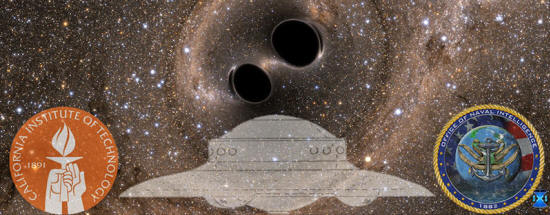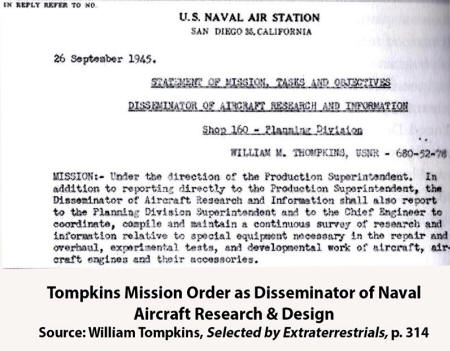|
On February 11, scientists at the Laser Interferometer Gravitational-Wave Observatory (LIGO), which is jointly run by the California Institute of Technology (Caltech) and the Massachusetts Institute of Technology (MIT), publicly announced the detection of gravity waves, first predicted by Albert Einstein in his Theory of General Relativity (1915).
The scientific discovery supports claims by whistleblowers concerning the existence of gravity wave propulsion (antigravity) technologies secretly studied by the U.S. Navy, in conjunction with Caltech, MIT and other scientific institutions, which date back as far as 1942...
LIGO achieved its scientific feat by studying the collision of two distant black holes, which generated gravity waves that sensitive monitoring equipment could detect through fluctuations in the space time continuum.
A press release by Caltech and LIGO announced:
The power generated by the black holes merging was enormous according to the press release:
Caltech astronomers played a key role in conceiving and building the scientific equipment to detect the gravity waves, and have produced a video illustrating how the colliding black holes bend space and time locally, and generated gravity waves that would spread throughout the universe.
While the existence of gravity waves were first demonstrated in the 1970s by Joseph Taylor and colleagues, the February 11 announcement supposedly broke new ground insofar as this was the first time that gravity waves had been scientifically observed and measured.
In this regard, Caltech's David H. Reitze, executive director of the LIGO Laboratory said:
What Reitze is not publicly acknowledging is that some of Caltech's leading scientists were aware that gravity waves had been earlier detected in Nazi Germany in top secret aerospace projects focused on developing innovative propulsion systems.
According to William Tompkins, who worked for U.S. Navy Intelligence at Naval Air Station, San Diego, from 1942 to 1945, the Navy was receiving debriefings from 28 spies embedded in top secret Nazi aerospace projects.
The Navy spies were revealing Germany's progress in developing flying saucer craft, some of which used gravity waves as a means of propulsion.
In his autobiography, Selected by Extraterrestrials, Tompkins provided documentation revealing that his service mission was to disseminate the results of the Navy Intelligence debriefings to select military facilities and scientific organizations.
Among the facilities visited by Tompkins was China Lake, where the Navy and Caltech were cooperating in studying the various aerospace technologies under development in Nazi Germany.
On February 12, Tompkins confirmed that among the debriefing packages he delivered to China Lake was information concerning gravity wave propulsion technologies then being studied in Nazi Germany. Tompkins said that the Nazis had multiple underground facilities in Europe where they were at various stages of development in designing and constructing advanced aerospace technologies.
I asked Tompkins whether Caltech was made aware, as far back as 1942, that the Germans were using gravity waves as part of the propulsion system for their space craft.
He replied:
Tompkins testimony reveals that more than 70 years before Caltech's February 11 announcement that gravity waves had been scientifically detected.
Leading Caltech and MIT scientists, from 1942 to 1945, were aware of the work done by the Nazis in detecting and developing gravity waves as part of the propulsion system for advanced aerospace projects.
The way in which gravity waves are used to propel spacecraft is illustrated by the testimony of another whistleblower, who is also linked with U.S. Navy Intelligence.
Bob Lazar says that in 1988, he was recruited to work out of a remote location at Nevada's Area 51, called S-4, where he studied one out nine flying saucers that were at the highly classified facility.
Lazar provided a W-2 in support of his testimony that listed his employer as the "Department of Naval Intelligence," which 'officially' hasn't existed since a brief period during World War II.
Researchers found that the address on the W-2 was redirected by the U.S. Postal Service to Naval Intelligence Command in Maryland.
Lazar says that the flying saucer he studied used gravity waves powered by an antimatter generator based on element 115.
It's important to note that at the time of his public emergence in 1989, 115 had not yet been discovered. It was over a decade later, in 2003, that an unstable isotope of 115 was first created in a laboratory, and in December 2015 it was officially added to the table of periodic elements as Ununpentium.
Bob Lazar was claiming that a stable isotope of 115 existed, and that it was used for generating gravity waves as he described in an interview with popular Las Vegas news host George Knapp.
Lazar went on to describe the capabilities of gravity wave propulsion systems:
Lazar's testimony is very significant since it reveals that in 1988-1989, a branch of U.S. Navy Intelligence was studying gravity wave propulsion systems - more generally known as antigravity - that had been successfully developed in flying saucers located at S-4.
According to yet another whistleblower, a former CIA agent who used the pseudonym 'Kewper', four of the flying saucers he saw at S-4 in 1958 were developed in Germany by the Nazis and the mysterious Vril Society.
Kewper's testimony helps corroborate claims that the Nazis had successfully developed antigravity technologies for their advanced aerospace programs.
Based on the testimony of Tompkins, Lazar and 'Kewper', it can be concluded that in 1942, US Navy Intelligence had begun receiving briefings about the Nazis developing gravity wave propulsion systems, and that several flying saucers of Nazi and other unknown origins were later secretly studied at Area 51's S-4 facilities.
Consequently, the announcement by Caltech and MIT astronomers claiming that gravity waves were detected for the first time in 2015 is at best incorrect, and, at worst, an attempt to falsify the historical record.
The U.S. Navy's role in gathering intelligence on Nazi Germany's advanced aerospace projects, which included the development of antigravity propulsion systems, confirms that gravity waves were first detected as far back as 1942, if not earlier, and this was revealed to select scientists at both Caltech and MIT.
|




